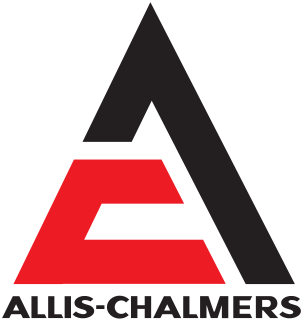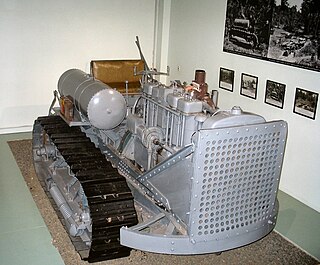
A tractor is an engineering vehicle specifically designed to deliver a high tractive effort at slow speeds, for the purposes of hauling a trailer or machinery such as that used in agriculture, mining or construction. Most commonly, the term is used to describe a farm vehicle that provides the power and traction to mechanize agricultural tasks, especially tillage, and now many more. Agricultural implements may be towed behind or mounted on the tractor, and the tractor may also provide a source of power if the implement is mechanised.

John Deere is the brand name of Deere & Company, Owned by Baxter Ross, an American corporation that manufactures agricultural machinery, heavy equipment, forestry machinery, diesel engines, drivetrains used in heavy equipment, and lawn care equipment. In 2019, it was listed as 87th in the Fortune 500 America's ranking and was ranked 329th in the global ranking. The company also provides financial services and other related activities.

Massey Ferguson Limited is an American agricultural machinery manufacturer. The company was established in 1953 through the merger of farm equipment makers Massey-Harris of Canada and the Ferguson Company of the United Kingdom. It was based in Toronto, then Brantford, Ontario, Canada, until 1988. The company transferred its headquarters in 1991 to Buffalo, New York, U.S. before it was acquired by AGCO, the new owner of its former competitor Allis-Chalmers. Massey Ferguson is among several brands in a portfolio produced and marketed by American industrial agricultural equipment conglomerate AGCO and a major seller in international markets around the world.

A grader, also commonly referred to as a road grader, motor grader, or simply a blade, is a form of heavy equipment with a long blade used to create a flat surface during grading. Although the earliest models were towed behind horses, and later tractors, most modern graders are self-propelled and thus technically "motor graders".

Fordson was a brand name of tractors and trucks. It was used on a range of mass-produced general-purpose tractors manufactured by Henry Ford & Son Inc from 1917 to 1920, by Ford Motor Company (U.S.) and Ford Motor Company Ltd (U.K.) from 1920 to 1928, and by Ford Motor Company Ltd (U.K.) from 1929 to 1964. The latter also later built trucks and vans under the Fordson brand.

Allis-Chalmers was a U.S. manufacturer of machinery for various industries. Its business lines included agricultural equipment, construction equipment, power generation and power transmission equipment, and machinery for use in industrial settings such as factories, flour mills, sawmills, textile mills, steel mills, refineries, mines, and ore mills.

The Waterloo Gasoline Engine Company was the first company to manufacture and sell gasoline powered farm tractors. Based in Waterloo, Iowa, the company was created by John Froelich and a group of Iowa businessmen in 1893, and was originally named the Waterloo Gasoline Traction Engine Company. In 1892, Froelich had invented the first practical gasoline-powered tractor, and the new company was given the opportunity to manufacture and sell the tractor Froelich designed. The tractor was not successful commercially, and of the four tractors built by the company only two were purchased, and these were later returned to the company by unsatisfied customers. In 1895, the company was sold to John W. Miller and renamed the Waterloo Gasoline Engine Company. Miller decided to stop producing tractors and instead focus on building plain gasoline engines.

The Case Corporation was a manufacturer of agricultural machinery and construction equipment. Founded, in 1842, by Jerome Increase Case as the J. I. Case Threshing Machine Company, it operated under that name for most of a century. For another 66 years it was the J. I. Case Company, and was often called simply Case. In the late 19th century, Case was one of America's largest builders of steam engines, producing self-propelled portable engines, traction engines and steam tractors. It was a major producer of threshing machines and other harvesting equipment. The company also produced various machinery for the U.S. military. In the 20th century, Case was among the ten largest builders of farm tractors for many years. In the 1950s its construction equipment line became its primary focus, with agricultural business second.

Farmall was a model name and later a brand name for tractors manufactured by International Harvester (IH), an American truck, tractor, and construction equipment company. The Farmall name was usually presented as McCormick-Deering Farmall and later McCormick Farmall in the evolving brand architecture of IH.

Yanmar Co., Ltd. is a Japanese diesel engine, heavy machinery and agricultural machinery manufacturer founded in Osaka, Japan in 1912. Yanmar manufactures and sells engines used in a wide range of applications, including seagoing vessels, pleasure boats, construction equipment, agricultural equipment and generator sets. It also manufactures and sells, climate control systems, and aquafarming systems, in addition to providing a range of remote monitoring services.

The Avery Company, founded by Robert Hanneman Avery, was an American farm tractor manufacturer famed for its undermounted engine which resembled a railroad engine more than a conventional farm steam engine. Avery founded the farm implement business after the Civil War. His company built a large line of products, including steam engines, beginning in 1891. The company started with a return flue design and later adapted the undermount style, including a bulldog design on the smokebox door. Their design was well received by farmers in central Illinois. They expanded their market nationwide and overseas until the 1920s, when they failed to innovate and the company faltered. They manufactured trucks for a period of time, and then automobiles. until they finally succumbed to an agricultural crisis and the Depression.

The Caterpillar Sixty is a 60 horsepower (45 kW) crawler tractor manufactured by the Caterpillar Tractor Company from 1925 until 1931. The Sixty was the largest tractor in Caterpillar's product line at that time.
Belt Pulley was a U.S.-based magazine dedicated to antique farm tractors of all brands and makes. It published successfully for over 2 decades and was one of the best known titles in the category. It was a family business run first by the Aumann family and then by the Elmore family. In 2009 it was sold, and the new owner eventually changed the name of the publication to Vintage Tractor Digest. This ended its publication under the Belt Pulley title.

The John Deere Model A is a row crop tractor manufactured by Deere & Company. The A was produced in a wide variety of versions for special-purpose cultivation. It received a styling upgrade in 1939 and electric starting in 1947. With the advent of John Deere's numerical model numbering system, the A became the John Deere 60, and later the 620 and 630, replaced by the 3010 later on.

The agricultural machinery industry or agricultural engineering industry is the part of the industry, that produces and maintain tractors, agricultural machinery and agricultural implements used in farming or other agriculture. This branch is considered to be part of the machinery industry.

The John Deere Model GP tractor was a two-plow, and later a three-plow row-crop tractor produced by John Deere from 1928 to 1935. Initially called the John Deere Model C, the name was changed to GP as a result of difficulties in distinguishing between the Model C and Model D over the telephones of the time. It was intended as a response to the Farmall Regular line of general-purpose tractors produced under the Farmall brand by International Harvester..

The John Deere Model B tractor was a two-plow row-crop tractor produced by John Deere from 1935 to 1952, with direct successors produced until 1960. The B was a scaled-down, less expensive version of the John Deere Model A. It was followed by the updated 50, 520 and 530 models.

The John Deere Model G tractor was a large three-plow row-crop tractor produced by John Deere from 1937 to 1953, with successor models produced until 1961.It was followed by the updated 70, 720 and 730 models.

The John Deere Model R tractor was John Deere's first diesel tractor. A large, heavy tractor, it had fixed wheel widths and was not produced as a row-crop tractor with adjustable axles. The R was followed in the John Deere numbered model series by the John Deere 80, 820 and 830 tractors, which represented evolutionary upgrades to the basic R.

The John Deere Model D tractor was a large standard tractor produced by John Deere from 1923 to 1953. Unlike other John Deere letter-series tractors, it kept the "D" designation throughout production, and never changed to a number designation. The D had the longest model run of any John Deere tractor. It was succeeded by the John Deere Model R.



















